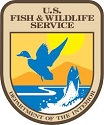 Last month, the folks at USA TODAY 10 Best asked the public to choose the best places to see various critters. Not surprisingly, National Wildlife Refuges were popular spots in all three categories. None of the winners near you? Find a refuge close by at http://www.fws.gov/refuges/refugeLocatorMaps/index.html
Last month, the folks at USA TODAY 10 Best asked the public to choose the best places to see various critters. Not surprisingly, National Wildlife Refuges were popular spots in all three categories. None of the winners near you? Find a refuge close by at http://www.fws.gov/refuges/refugeLocatorMaps/index.html
 |
| American Bison are native to the Oklahoma Prairie. Photo by R Wood/USFWS |
1. Wichita Mountains Wildlife Refuge – Oklahoma
At Wichita Mountains, which won an earlier 10 Best as best National Wildlife Refuge, three native herds dominate its 59,000 acres – American bison, Rocky Mountain elk and white-tailed deer. A total of 240 species of birds, 50 species of mammals, 64 species of reptiles and amphibians, and 36 species of fish have been documented on the refuge.
4. Rocky Mountain Arsenal National Wildlife Refuge – Colorado
One of the latest draws at Rocky Mountain Arsenal is the black-footed ferret, the most endangered mammal in North America. Its 15,000 acres of prairie and lakes attract raptors, migrating songbirds, wintering ducks and geese, and provide habitat for a variety of mammals including bison, coyotes and deer.
10. Kodiak National Wildlife Refuge – Alaska
You say Kodiak, and its namesake brown bears spring to mind. But bald eagles, salmon, and a diversity of other fish and wildlife abound on the 1.9 million acres of pristine upland and waters.
Best Place to See Aquatic Life
 |
| Manatees swimming near Crystal River National Wildlife Refuge in Florida.
Photo by Keith Ramos/USFWS |
3. Crystal River National Wildlife Refuge – Florida
Crystal River is the only refuge created specifically for the protection of the endangered Florida manatee, a subspecies of the West Indian manatee.
4. Kilauea Point National Wildlife Refuge – Hawaii
Spinner dolphins, humpback whales, Hawaiian monk seals and green turtles can all be spotted in the waters or on the beach below Kilauea Point.
7. J. N. “Ding” Darling National Wildlife Refuge – Florida
It may be best known for its bevy of beautiful birds, but Ding Darling has manatees, crocodiles, terrapins, frogs, fish and more.
 |
| Whooping Cranes at Aransas National Wildlife Refuge.
Photo by Steve Hillebrand/USFWS |
1. Aransas National Wildlife Refuge – Texas
The mild winters, bay waters and abundant food supply attract more than 400 species of birds to the Aransas. But one species of that 400 stands out: the whooping crane, one of North America’s rarest birds. The only natural wild flock of whooping cranes winters at Aransas. All of the whooping cranes alive today, both wild and captive, are descendants of the last 15 remaining cranes that were found wintering at the refuge in 1941.
2. Ottawa National Wildlife Refuge/Magee Marsh – Ohio
Much of Ottawa Refuge and the surrounding lands, on the shore of Lake Erie, were part of the Great Black Swamp. The 1,500 square mile Great Black Swamp was a vast network of forests, wetlands and grasslands. The refuge manages about 6,500 acres of wetland, grassland and wooded habitat. It provides valuable habitat for a diversity of waterfowl and other migratory birds. For instance, Ottawa may host as many as 38 different species of warbler including the yellow-rumped warbler during migration season.
7. Kilauea Point National Wildlife Refuge – Hawaii
Each year, thousands of migratory seabirds use double winner Kilauea Point for nesting, foraging or resting. Laysan albatross, red-footed boobies, brown boobies, red-tailed and white-tailed tropicbirds, great frigatebirds and wedge-tailed shearwaters all visit the refuge. In addition, migratory shorebirds, such as the kolea can be seen August through May. A small population of endangered nene were reintroduced on the refuge in the 1990s and are continuing to do well.
8. Cape May National Wildlife Refuge – New Jersey
Cape May’s five-mile stretch along the Delaware Bay is a major resting and feeding area for migrating shorebirds and wading birds each spring such as the red knot. The arrival at Cape May of red knots and about 20 other shorebird species coincides with the horseshoe crab spawning season which occurs in May/early June. The crab eggs provide an abundant food supply these long-distance flyers use to replenish their energy reserves before moving on.
10. Bosque del Apache National Wildlife Refuge – New Mexico
Dancing Sandhill cranes draw visitors to Bosque del Apache each year for the Festival of Cranes. Other birds pass through the refuge on their way north or south. And some are year-round visitors.
